I have had the good fortune over the years to qualify for and compete at the renowned Longines/FEI World Breeding Championships for Young Horses (WBFSH) held annually in Europe for 5-, 6- and 7-year-olds. This event is particularly important to attend because by measuring ourselves against the European standard we gain valuable information. On the other hand, remember that being successful with your young horse is not really about whether or not you make it to the national or the world championships. It’s about the correctness of your training.
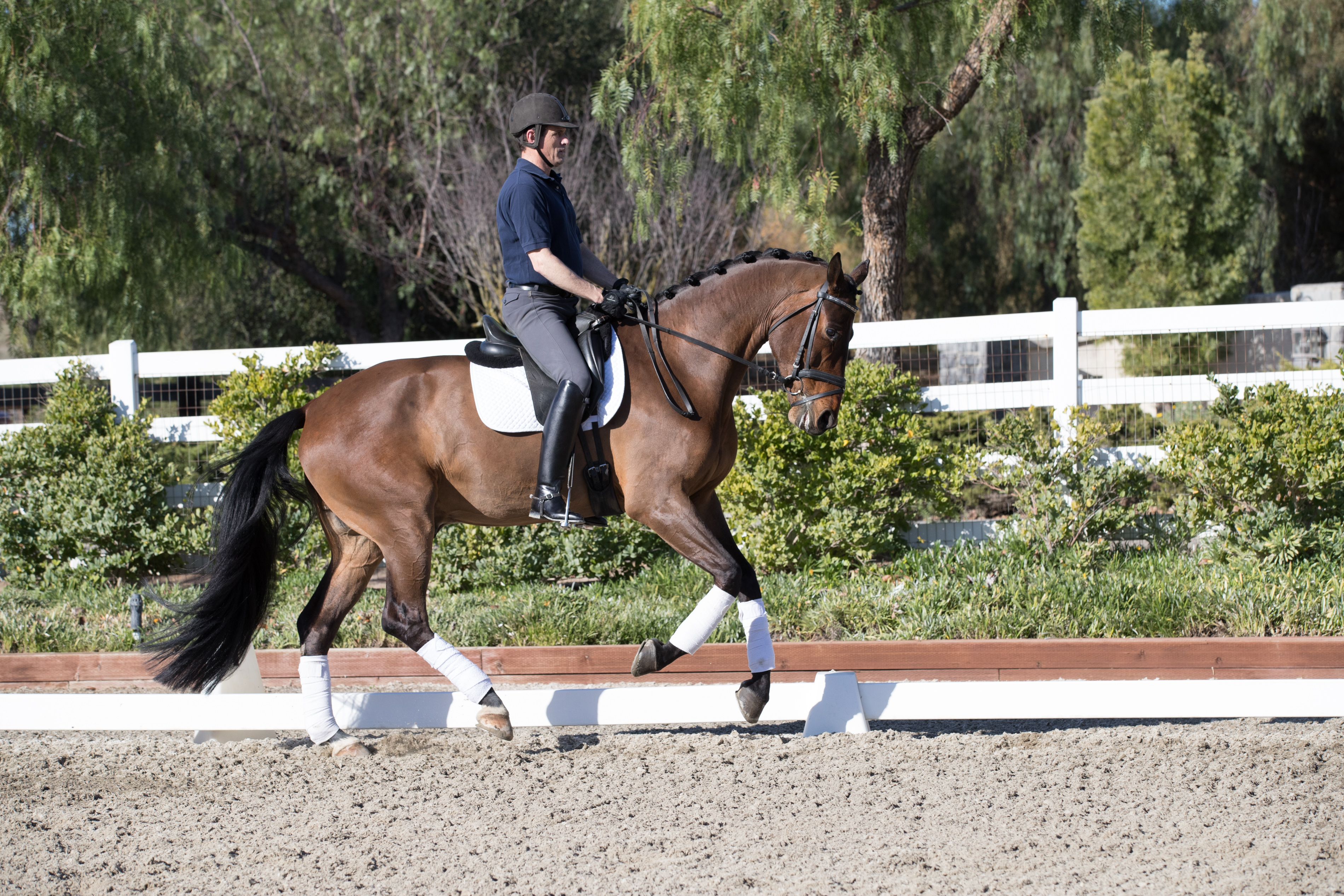
As the saying goes, “It’s the journey that matters” because the FEI Young Horse tests are just a step toward developing an FEI-level horse and later on, hopefully, an internationally competitive Grand Prix dressage horse.
Now let’s look at part of that process, which is how to train the horse for the 5-year-old FEI Young Horse competitions from January through August, when the U.S. National Championships are held and the WBFSH competition in Europe happens.
Prerequisites
I want to begin by briefly telling you what I look for in a 3- and 4-year-old prospect. The 3-year-old should already be able to walk, trot and canter under saddle. In the walk, I look for a big overstep, which means that the hind hoof steps on or over the print made by the front hoof on the same side. The walk shouldn’t lose rhythm when you ask the horse to make the steps smaller. In other words, you want a walk that does not become lateral when you make the steps smaller.
In the trot, I want to see elasticity. This means that the horse naturally swings through his back with hind legs that step well underneath his body.
The canter should be a clear three-beat gait that is not too big while still covering ground in stride. A too-big canter makes it difficult for the horse to collect later as you progress toward the Grand Prix. You need a canter that’s collectable.
At the end of the 4-year-old year the horse should be moving nicely forward and into the contact. He should bend a little on 20-meter circles and make some leg yields from the quarterline to the rail as well as starting a little counter canter.
The 5-Year-Old’s Daily Routine
So now it’s January of your horse’s 5-year-old year and your goal is to be one of the top 15 horses in the country qualifying for the big Markel/USEF Young & Developing Horse Dressage National Championships, held at Lamplight Equestrian Center in Wayne, Illinois, usually in August.
Whether you live in a warm or cold climate, here is the first question to ask yourself as you begin this year’s training: Is my horse moving nicely forward into the contact in the walk, trot and canter? This contact should feel like the horse is gently pulling you along as he moves forward.
Walk: Normally in a daily workout, you probably begin by walking your horse for 10 minutes on a long rein before taking contact and starting to trot. Sounds good, right? But I’ve found that it is often best to leave the walk work until the end of the workout. Remember, your young horse may be fresh or tense, especially if it’s cold outside. So sometimes instead of the initial 10-minute walk, I’ll often start trotting right away or I might even canter a bit. This can help to get the tension out. Once the horse relaxes, it’s time to walk on a long rein.
Every day I pay attention to the contact to the bit, asking for the horse to become straighter on the long sides.
Corners: Corners are the cornerstones of being able to ride a good dressage test. So it’s important to take the time to explain to the horse how to properly bend his body and balance through them. In February, I begin teaching this to the horse by adding trot–walk transitions before the corners. The basic pattern is to approach a corner at the trot. About 5 meters before the corner I ask him to walk. I walk through the corner and then ask for trot again. Soon I will trot, walk and then leg yield the horse off my inside leg and position his neck to the inside through the corner. I’m not too concerned about my outside leg at this point. Once I’m through the corner I want to make the horse straight on the long side again.

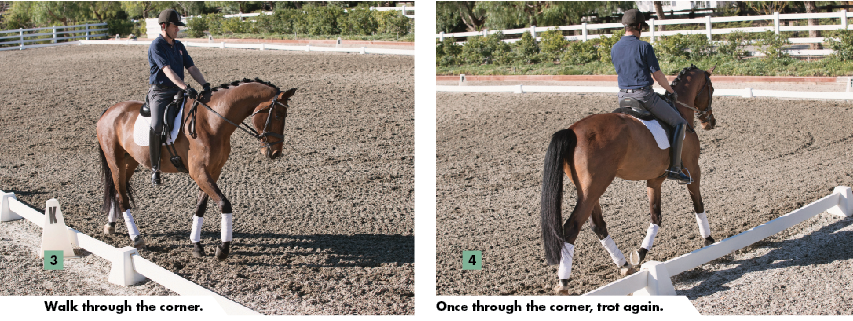
Trot: Once I start trotting, I focus on a steady contact to the bit—a contact where I can feel both sides of the horse’s mouth evenly. Contact is good. We want the horse moving forward into the contact, and from this we can start to develop rhythm, straightness and suppleness.
Many times a horse will grab the bit and drop it. If he grabs it, I close my fist and leg to add more pressure. If he drops the contact, I add more leg and try to push him to the contact.
In February I start to ask for 12-meter circles in sitting trot. The 12-meter circles are the key to keeping the horse balanced. There is no reason to do smaller 10-meter circles yet, and 15-meter circles are too big. I’ll do about five or six of these 12-meter circles every other day. This is a good way to work on the horse’s balance and suppleness.
Canter/Counter Canter: In the canter as well as in the walk, I want to develop a contact where I can follow the horse’s mouth and move with him. I don’t want a dropped rein. I want my arms to be elastic and to follow the horse’s mouth as he moves.
Now it’s time to work on the counter canter. I start by cantering on the diagonal toward R or S. Then I try to keep the canter lead as we turn through the short end. No worries if the horse breaks to trot. If he does, I keep trotting. I don’t stop, as this only creates more tension. The next day, I try the counter canter again. If the horse makes it a few meters farther I am happy with that progress.
In February, I start asking the horse to maintain the counter canter through the short end of the arena. When I ask for the counter canter it’s OK to have him a little overbent to help him keep the lead.
Turn on the haunches: In the 5-year-old test you need to perform a turn on the haunches. Here is how I teach it:
1. At home, I walk past C to the corner on the short end of the arena and use the corner to help me teach the horse the 180-degree turn.
2. I guide him through a half turn using my inside rein and outside leg. This is just to give him the idea of what I want. I don’t worry if the turn is not perfect; it’s not going to be. My goal is to make the turn fluid and forward-thinking. Keeping the feeling of going forward is the most important thing.
I’ve learned that once you start the turn on the haunches you need to work on it every day. You don’t have to do 20 of them, just two or three is enough. Believe me, by the time August comes around, the horse will know it. But in February, I’m still keeping the turn on the haunches large while making sure the horse is turning in front of my aids.
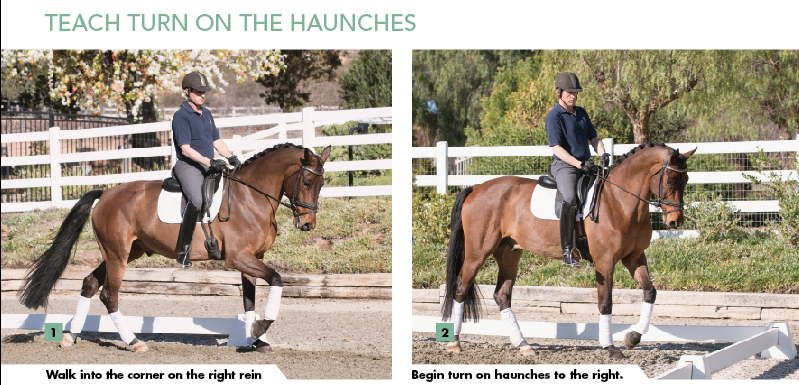
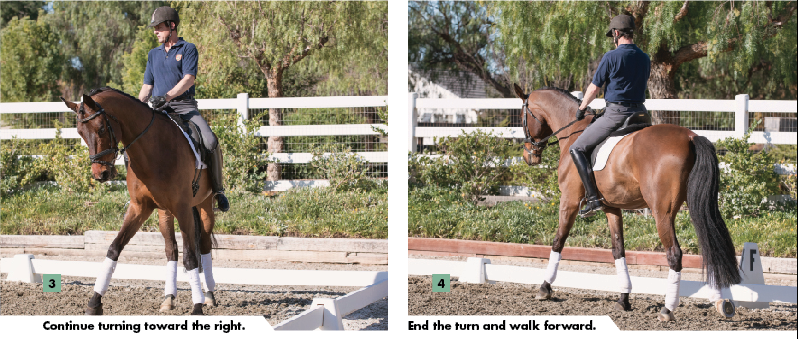
Transitions: The horse should be doing basic transitions already, but now we need to start work on walk–canter, canter–walk transitions. This is not as hard as you might think. When I ask for canter from the walk for the first time, my only goal is to get into the canter. I’m not that concerned with whether or not he stays perfectly on the bit or if he trots a few steps. Same goes for canter–walk. If he trots a few strides in between, it is OK.
When I go down from canter to walk, I basically just start by pulling gently on the reins until he comes to a walk. Although pulling on the reins isn’t typically encouraged in dressage, remember this is a young horse who hasn’t done this before. So I do transitions every day and they get smoother and steadier. You want him to engage his hind end before the transition. So the transition then becomes the outcome of collection in the canter. Transitions prepare him for developing the straightness and collection he will need later on.
The First Competition
In January, you want to look ahead to the qualifiers that start at the end of March. It is not too soon to begin to study the two FEI Young Horse 5-year-old tests (Preliminary and Final) that are used for the qualifiers. In the beginning of March our first qualifier is three weeks away, so my goal at this point is to be able to do the test quietly, building confidence along the way. Now at home, I start to practice the test pattern to see if I can do the test without big problems, which can include uneven rhythm in the gaits and not stretching over the back. If I have problems, I won’t enter the show. But I don’t mind if a circle is slightly large or if there is a trot step in the walk–canter or canter–walk transitions.
Once I am at the show and it’s time for my test, I get ready to enter at A at trot and halt at X. It’s really important to come in with a forward working trot. This will impress the judges. Just make sure the forward trot is balanced and not running.
So I trot into the arena and let the horse walk a step or two before the halt. The entry needs to be straight, and I always let the horse walk a step or two out of the halt as well. This is the perfect way to do it on a young horse because it keeps him relaxed and forward-thinking. Later in the collected trot there should be more engagement of the hind quarters than in working trot.
As I track left at C, I prepare the horse for a balanced turn before the serpentine. Once I make the turn onto the first serpentine loop, I start to ride with a medium-trot feeling because I want to show off my horse’s trot to the judges. I slow down through the short end (hoping this makes my medium trot look bigger). Because I rode quite forward during my three-loop serpentine, I need to show a difference for my medium trot.
Next, I walk a nice big turn on the haunches. I don’t mean huge, just slightly big and with the idea of riding forward. Once the turn is finished, right away I trot a 10-meter circle left. Here I really try to bend and balance the horse on the circle. I don’t want him to go around the turn leaning in as if I were riding my motorcycle!
Turn left at E, turn right at B. Sounds easy, but it’s not. Now I have to bend the horse left on the left turn and then right on the right turn, then circle right with balance and bend.
Now that the circles are finished, I ride a bit forward again and change rein at medium trot. This time I take a risk and ask for more. I want to get the maximum trot while still maintaining balance and rhythm. When you school the medium trot at home, do it rising. Remember, you still have a very young horse.
I want to make a quiet transition to medium walk at C. While changing rein down the diagonal to H, I try to follow with my arms while maintaining an elastic feel with the horse’s mouth. The reins should be longer than if you rode collected walk but shorter than a walk on a long rein. Also, I try to keep the poll not too low.
Then on the medium walk, on a long rein from H to P, I want the horse to stretch forward and downward with his head and neck while trying to keep his nose in front of the vertical. When I retake the reins, I am careful to keep the walk rhythm four-beat and I concentrate on straightness for the transition to canter.
I’m not bothered if the horse comes slightly above the bit for the transition to canter. Now we do medium canter down the long side. Here I don’t take too much of a risk. I just try to go forward and come back while lengthening the stride.
We do a half circle to turn down the centerline toward E before the counter-canter loop. Here I don’t worry if the turn is slightly large. I would rather have the turn be a little big and stay balanced. Remember it’s still very early in the year.
Next is the counter canter. Here I want to try to keep the lead and as much balance as possible. In the transition to walk, I just try to collect a bit in the canter then ask for the walk. A trot step or two doesn’t bother me at this point. On the transition to canter, I’m thinking about straightness. I want a prompt reaction off my leg.
Next is a medium canter down the long side. Here I take more risk because there is not a sharp turn onto the centerline.
I change rein through the short diagonal and hold the counter canter on the left lead. It’s especially important to ride an active three-beat canter. This doesn’t mean running. Now I do a simple change while thinking about straightness.
Next is a transition to trot then a stretch out and downward on a half 20-meter circle. This is where it’s really important that the horse goes to the contact. I try to follow the horse’s mouth forward and downward as he stretches. I want a real working trot with his nose in front of the vertical while we maintain contact.
Finally we go down the centerline in a forward working trot, halting at X and saluting the judges.
If you feel you have a quality horse, you should absolutely try the Young Horse classes because it is really important to get feedback on your training and the quality of the gaits. Good luck.
Learn more: David Wightman shares how he qualified three young horses to compete in Europe. Click here.
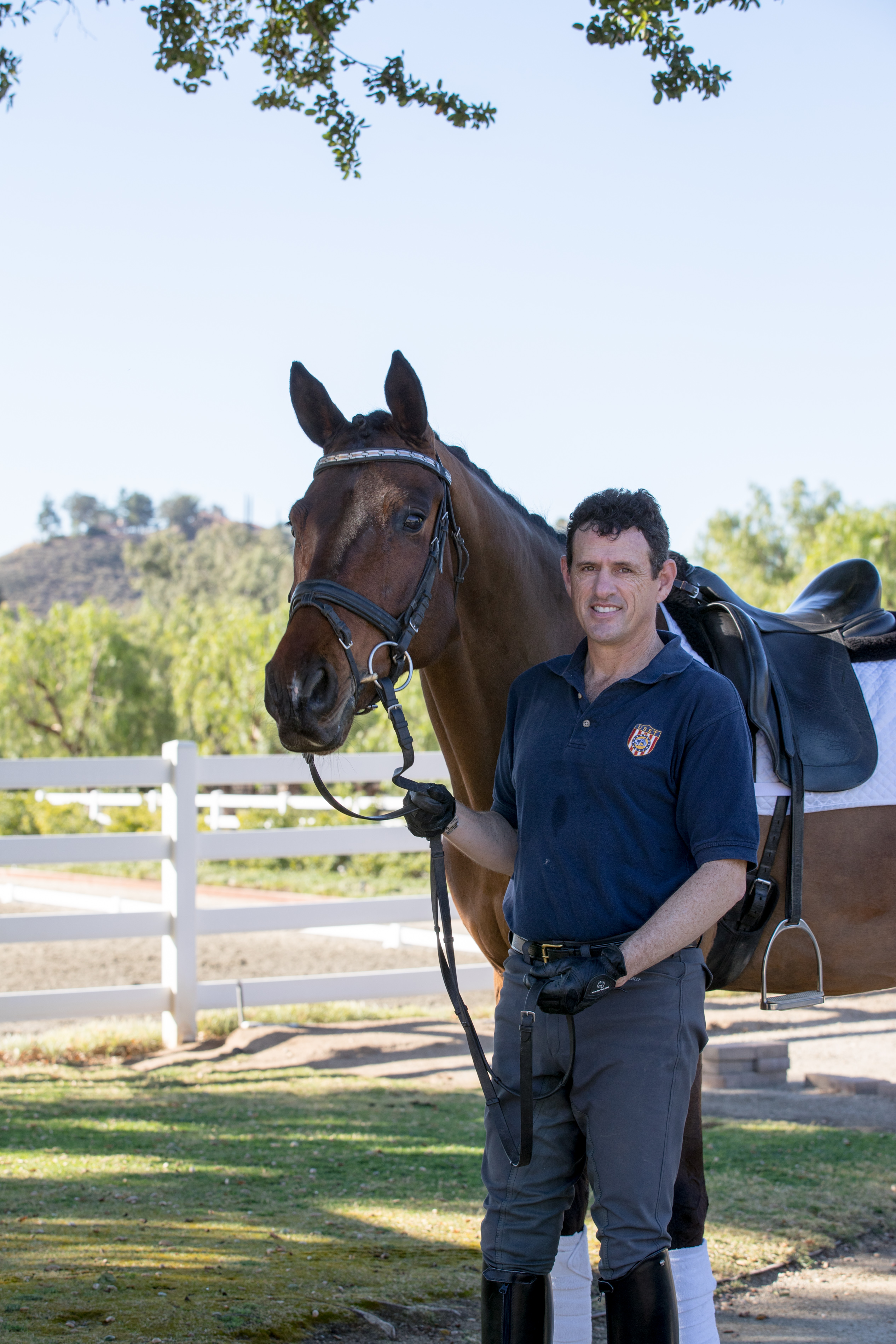
David Wightman is a Grand Prix dressage rider, teacher and trainer at his Adventure Farm in Murietta, California. He has a busy clinic schedule around the country and has coached many Young Riders nationally and internationally, including taking them to top placings in the Under-25 division in Europe. In 2017, along with his wife, U.S. Olympian Kathleen Raine, he coached Alyssa Doverspike and her Hanoverian gelding, Darius 555, to win the prestigious U.S. Young Horse Championship for 5-year-old dressage horses. He met Kathleen when they both worked for Olympian Hilda Gurney. After five years, the couple married and began their own teaching and training business. He has trained with Johann Hinnemann, Dennis Callin and Christine Traurig.











